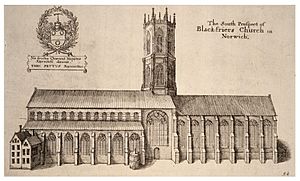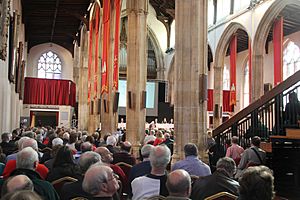St Andrew's and Blackfriars' Hall, Norwich facts for kids
Quick facts for kids St Andrew's Hall and Blackfriars' Hall |
|
|---|---|

St Andrew's Hall
|
|
| Type | priory church and convent buildings |
| Location | Norwich |
| Built | 1307 onwards |
| Governing body | Norwich City Council |
|
Listed Building – Grade I
|
|
| Lua error in Module:Location_map at line 420: attempt to index field 'wikibase' (a nil value). | |

St Andrew's Hall and Blackfriars' Hall, often called The Halls, are a group of very old buildings in the city of Norwich, England. They were once a church and other buildings for a group of monks called the Dominicans. These buildings date back to the 14th century, which means they are over 600 years old!
They are special because they are the most complete set of old church buildings from before the Reformation that still exist in England. The main part is St Andrew's Hall. Today, The Halls are used for many different events. People hold conferences, weddings, and concerts there. They even have beer festivals and meetings. Up to 1,200 people can fit inside. The Halls are also one of the Norwich 12 heritage sites, which means they are very important historical places in Norwich.
Contents
History of The Halls
How the Friars Arrived
In the middle of the 13th century, a religious group called the Friars of the Sack came to Norwich. They settled in an area that included the parishes of St Andrew and St Peter Hungate.
By the early 1300s, this group was getting smaller. In 1307, another religious group, the Dominican Order, took over the site. The Dominicans were also known as the Black Friars because of their dark robes. They were allowed to take over by the king, but only if they promised to look after the very last Friar of the Sack who was still living there.
Building After the Great Fire
The first church and buildings on this site were destroyed in 1413. A big fire swept through Norwich that year, burning down a large part of the city.
The second church building, which is the one you can see today, was finished in 1470. The main part of this new church, called the nave, is now St Andrew's Hall. The area where the altar used to be, known as the chancel, is now Blackfriars’ Hall. There is also a crypt (an underground room), a chapel (a small church), and cloisters (covered walkways) that are part of the complex.
New Uses for Old Buildings
During a time called the Reformation, many religious buildings in England were destroyed. But the City Corporation (the local government of Norwich) saved this site. They bought it from the king to use as a 'common hall' for the city.
Since then, The Halls have been used for many different things. They have been a place of worship, a mint (where coins were made), and even a workhouse (a place where poor people could live and work). Since 1544, they have been regularly used for important city events. The first Mayor's feast, celebrating Henry Fuller becoming Mayor, was held there. The Norfolk and Norwich Festival, one of the oldest festivals in the country, started at The Halls in 1824.


